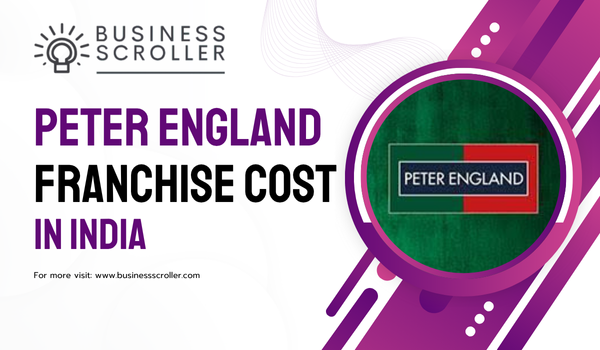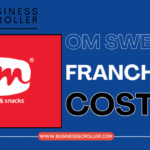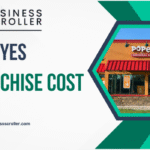If you’re thinking of owning a branded men’s-wear store in India, Peter England is one of the most recognizable and affordable options in the mass-market apparel category. This guide — written from the perspective of an Indian franchise expert — breaks down the franchise model, investment ranges you can expect, likely returns, who’s eligible, the step-by-step application process, and practical tips to increase your chance of success.
Why Peter England?
Peter England, part of the Aditya Birla Fashion & Retail Ltd. (ABFRL) family, has a strong presence across India in affordable menswear — shirts, trousers, jeans, casuals and formals — making it a stable choice for retail investors focusing on volume sales and repeat customers. ABFRL manages the brand’s retail strategy and supports franchise/stores with supply chain, marketing and merchandising expertise.
Franchise Model

Peter England runs through a few retail formats: company-owned stores, franchise/partner stores and shop-in-shop or consignment arrangements with retailers. Depending on location and agreement, many Peter England partnerships operate on either a standard franchise model or a sale-or-return / consignment-type model where inventory risk and margins are handled per contract. This means ABFRL often helps with stock allocation and merchandising guidance, while franchise partners focus on store operations, local marketing and customer service.
Investment / Franchise Cost
Estimates for initial investment vary by source because cost depends heavily on city/town tier, store format, mall vs. high-street presence, interior fit-out choices and inventory size. Public franchise listings and industry portals commonly report the following ballpark ranges:
- Lower range (small town / smaller format): ≈ ₹25–30 lakh (store space ~800–1,000 sq.ft, limited inventory).
- Typical range for Tier-2 / Tier-3 & mall formats: ₹50 lakh – ₹1 crore (includes higher inventory, professional fit-out, signage, initial marketing).
What these numbers usually include: security deposit (if any), shop fit-out and fixtures, initial stock, POS/IT setup, staff hiring & training, working capital for first 3–6 months, and local marketing. Franchise fee itself is often modest or embedded in the overall investment; some listings show a token brand fee while others report consignment/commission structures — always confirm from the company for the exact breakup.
Store size & location
Most sources point to an ideal shop size of ~800–1,200 sq.ft for a standalone Peter England outlet — this balances SKUs display, customer flow and operating economics. Location matters: high footfall malls, busy high-streets and markets in Tier-2 towns with good parking deliver faster break-even than low-visibility locations.
Expected ROI & payback
ROI depends on rent, staff costs, average basket size and monthly sales. Industry listings suggest expected monthly sales targets in the range of several lakhs for established locations, with projected ROI figures varying widely (some portals quote 25–40% as indicative). Conservative planning assumes 12–36 months for payback depending on location and cost control. These are estimates — your actual numbers will depend on local demand, inventory turns, and operational discipline.
Eligibility Criteria
Although exact criteria are set by ABFRL and may vary by region, common expectations for franchise applicants include:
- Proven business/retail experience (preferred) or adequate financial capacity.
- Ability to invest the required capital and provide a security deposit (if asked).
- Ownership/long-term lease of a suitable retail space (or strong capability to secure prime locations).
- Willingness to follow brand guidelines, visual merchandising, pricing and promotions.
- Clean credit and local reputation; sometimes background/financial verification is part of the process.
Always request the official franchise terms from ABFRL for the definitive checklist.
Documents you should prepare
- Identity proof (PAN, Aadhaar, passport etc.)
- Address proof and business registration (if applicable)
- Bank statements / proof of funds for the last 6–12 months
- Lease agreement or property ownership proof for the proposed location
- Resume or business profile showing retail experience
- Neat photos/layout plan of the proposed store location
Having these ready speeds up the evaluation process.
Steps to apply — practical checklist
- Initial research & budgeting: Fix your budget (including 6–9 months working capital).
- Contact ABFRL / Peter England franchise team — use official franchise email listed below to request the franchise pack and MoU. (See official emails in the next section.)
- Share your location details & documents: Send the store address, photos and documents requested.
- Site visit & evaluation: ABFRL’s retail team will typically do a site assessment.
- Commercial terms & negotiation: Franchise fee, security deposit, revenue share/consignment terms and length of agreement are finalized.
- Store fit-out & training: On signing, you’ll receive brand guidelines, merchandising plan and staff training.
- Launch & Ongoing support: Brand-led marketing support and periodic reviews help ramp up sales.
Official contact — who to email
For franchise enquiries, use ABFRL’s official franchise contact email:
- franchiseenquiry@abfrl.adityabirla.com.
For store/online customer support queries you may also see:
- happytohelp@abfrl.in (customer/online queries).
Always send a concise mail with: subject “Peter England Franchise Enquiry — [City]”, brief financial capability, proposed location details (address or mall name), and attachments (POI, bank proof, resume).
Practical tips before you commit
- Visit multiple Peter England outlets in similar towns to compare sales and customer mix.
- Negotiate rent: lower rent reduces payback time the most.
- Start lean on inventory: focus on high-turn SKUs initially; increase depth as demand stabilizes.
- Localize marketing: collaborate with the brand’s marketing calendar (festivals, back-to-school) and add local touchpoints (influencers, college tie-ups).
- Understand online vs offline pricing to avoid channel conflict; brands usually have clear policies on promotions.
Final word
Peter England is a strong mass-market brand backed by ABFRL’s retail muscle. If you can secure the right location and manage inventory and costs tightly, the brand’s customer pull and organised supply chain can make it a viable retail investment. But because public estimates vary, your first step should be to email the official franchise team at franchiseenquiry@abfrl.adityabirla.com and request the latest franchise brochure, investment breakup and territory availability.

Shashi Kant is the Founder and Editor of BusinessScroller.com, a leading platform for business insights, finance trends, and industry analysis. With a passion for journalism and expertise in business reporting, he curates well-researched content on market strategies, startups, and corporate success stories. His vision is to provide valuable information that empowers entrepreneurs and professionals. Under his leadership, BusinessScroller.com has grown into a trusted source for in-depth articles, customer care guides, and financial expertise.


